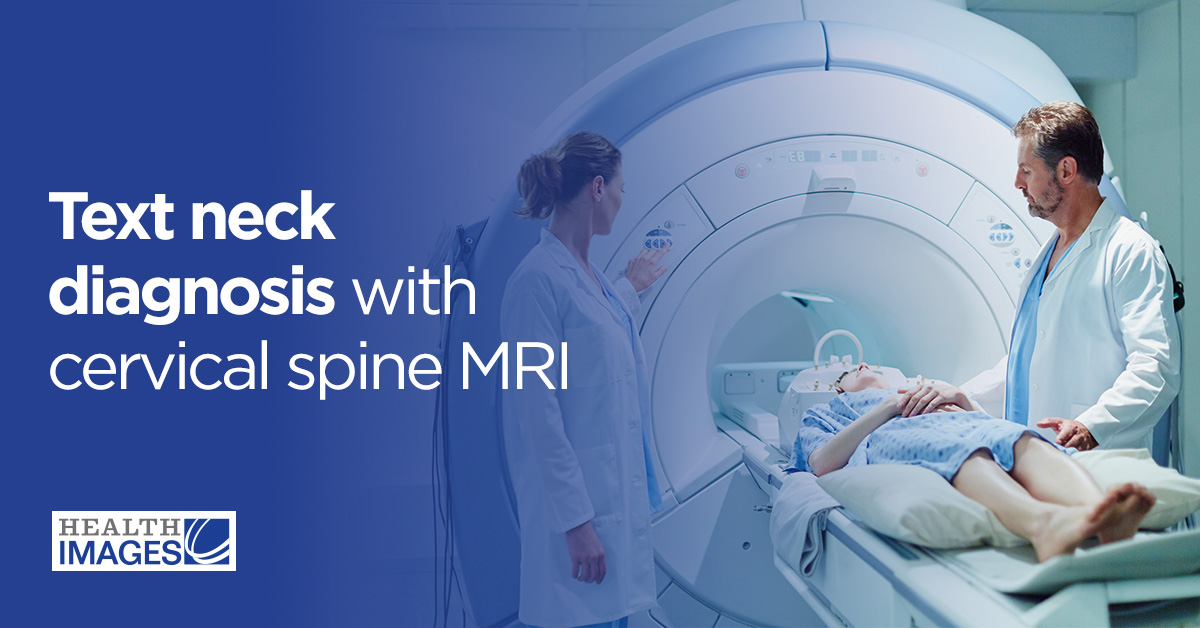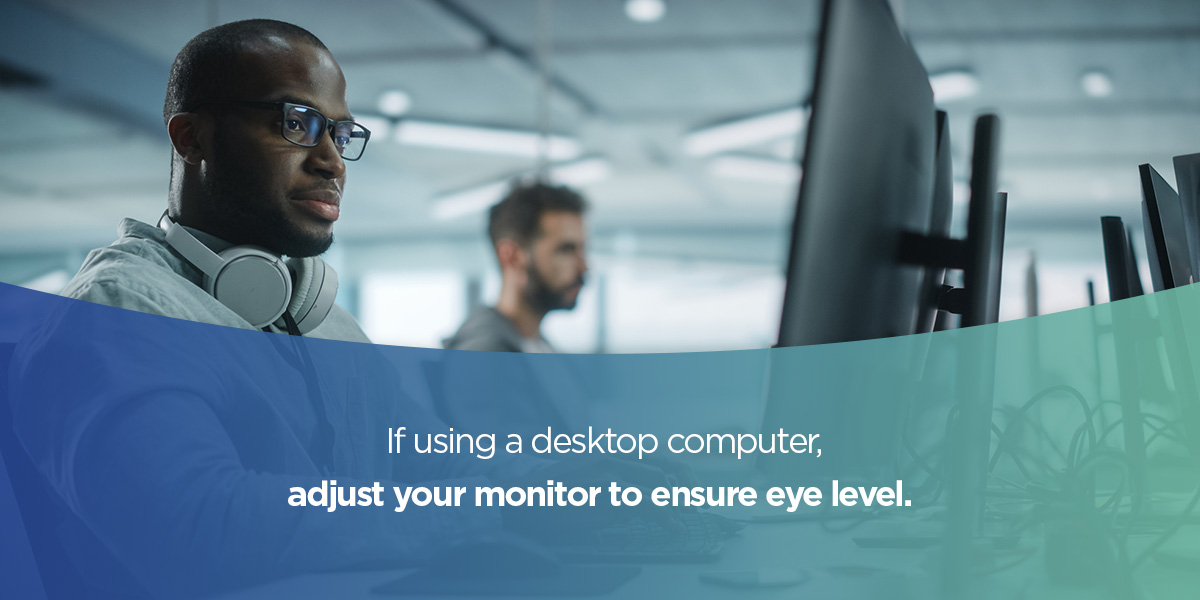Text Neck Diagnosis with Cervical Spine MRI
Increasing reliance on cellphones and computers has made shoulder and neck pain more common in recent years. If you’re a frequent technology user experiencing neck and shoulder pain, stiffness or weakness, you may be dealing with text neck syndrome, a repetitive stress injury from leaning your head forward for an extended period.
Fortunately, we’re here to help if you’re seeking relief from text neck pain and discomfort. Here’s everything you need to know about the condition, from causes and symptoms to diagnosis and treatment.
What is text neck syndrome?
When using a mobile device, you may unconsciously hunch your shoulders and bend your head forward. However, this posture puts pressure on the neck over time, resulting in a condition called “text neck” or “tech neck.” Frequently bending forward can affect the neck and shoulder muscles, supporting ligaments and the curvature of your cervical spice.
Text neck isn’t an official medical diagnosis, but more so a term for a repetitive stress injury that stems from excessive mobile device use. People of all ages can experience text neck. The good news is that it’s easily reversible or preventable by modifying your workspace, improving your head and neck posture and practicing stretching exercises.
Text neck symptoms
Text neck syndrome can cause the following symptoms.
- Pain: Pain in the neck, shoulder or upper back is a typical characteristic of text neck. It can range from a dull ache to a sharp pain. It might be general soreness spreading from the lower neck to the shoulders, or intense pain in one specific area. Text neck pain tends to worsen when flexing the neck forward, like when looking down at a phone screen. In some cases, the muscles at the base of the neck can go into spasm.
- Reduced mobility: Text neck can cause tightness, making it difficult to move your neck. Your upper back and shoulders may also experience stiffness and reduced mobility.
- Muscle weakness: Your shoulder muscles, like the trapezius, rhomboid and external rotators, can weaken with constant strain.
- Headaches: Chronic headaches can stem from tight suboccipital muscles. Posture aside, excessive time spent looking at screens can also increase the risk of headaches and eyestrain.
The pain’s location, degree and severity can vary by person and circumstance. For instance, someone who frequently looks at a phone screen while using both hands may be more prone to evenly distributed pain on both sides of the neck or upper back. Meanwhile, someone who uses one hand may experience more severe pain on that side due to increased strain on those muscles.
Text neck treatment and prevention tips
If you’re wondering how to fix tech neck, here are some recommended practices to try at home or work.
1. Improve your workspace
Make sure your chair has good lumbar support or place a pillow behind the small of your back. Experts recommend an office chair with armrests that allow your feet to rest flat on the floor. Keep your knees and hips at or slightly greater than 90 degrees. Use a book or box as a footrest if your feet aren’t flat on the floor.
An external monitor separate from your laptop is also ideal, placed roughly an arm’s length away with the top of your monitor at or below eye level. Use a box or book to elevate the monitor if necessary. You can also adjust your blinds or position your monitor perpendicular to any windows to reduce screen glare.
2. Practice good posture
Sit upright and align your head directly with your spine. Your gaze should be straight in front of you rather than down toward the floor. If using a desktop computer, adjust your monitor to ensure eye level. Relax your shoulders, keep your elbows close to your body and position your feet flat on the floor.
When using a handheld device, try moving it closer to eye level or propping it up on books or pillows — that way, you aren’t tilting your head forward. Use a case that allows you to angle the phone for comfortable viewing.
Good standing posture is also critical. Remember to stand up tall and straight, pull your stomach in and keep your shoulders back.
3. Take breaks
Prolonged sitting can contribute to neck pain and stiffness. Try to get up and take a break every half an hour or so to stretch and move around. If needed, use an alarm or reminders to take frequent breaks from devices.
4. Stretch and exercise
Regularly stretching your core can support your spine and prevent back and neck pain. Stretches like chin tucks can strengthen the muscles aligning your head over your shoulders:
- Stand with your feet shoulder-width apart and your back against a wall, then tuck your chin down.
- Pull your head back so it’s resting against the wall.
- Hold this position for about five seconds and repeat several times.
Shrugging your shoulders up and down is another stretching exercise to try. You can also tilt your head sideways while stretching the opposite shoulder downward.
Cervical spine MRI for text neck pain
If your text neck symptoms aren’t improving with workspace upgrades, improved posture and exercise, they may indicate something more serious like degenerative disc disease, a condition resulting from the vertebral discs wearing down over time. Your doctor may order a magnetic resonance imaging scan to identify the cause of your shoulder or neck pain, determine if there’s any damage and provide an accurate diagnosis.
An MRI scan is a radiation-free, noninvasive diagnostic imaging technique providing concrete evidence about a suspected issue. It uses powerful magnets, computer technology, radio waves and detailed images to diagnose a condition.
In some instances, text neck may aggravate underlying conditions like cervical degenerative disc disease. Other issues like fractures, sprains, strains and thyroid issues can cause similar symptoms. A cervical spine MRI can help your health provider differentiate among these conditions. For example, an MRI might confirm issues from text neck, or it might reveal a thyroid nodule or disc-related problem.
If an MRI scan confirms signs of disc degeneration, there are multiple treatment options available like anti-inflammatory drugs, pain relievers, physical therapy and, in severe cases, surgery. Your doctor can create an effective treatment plan based on your cervical spine MRI results.
Request a cervical spine MRI from Health Images today
Text neck may injure the vertebrae and discs over time, and diagnostic imaging may be necessary to detect the source of the pain. If you’re experiencing widespread neck pain or the other symptoms above, try consulting a world-class diagnostic imaging provider like Health Images. Our experienced, compassionate team can help you determine an accurate diagnosis and remedy the condition.
With state-of-the-art equipment, personalized care and various medical imaging services, including x-rays, MRIs, CT scans and more, we can help address the root of your neck or shoulder pain and find a solution. Find one of our locations near you to request an MRI scan today.






